
Business and Labor Overview
Major Issues
- The Department of Insurance Has Restructured the Conservation and Liquidation Division. Under this restructuring, there are several organization and management issues that warrant legislative review. We recommend that the department report on these issues at budget hearings. (See page G-13.)
- Legislature Needs Information on Blue Cross Restructuring Plan. On September 15, 1994, Blue Cross of California submitted a plan to the Department of Corporations (DOC) which spun-off a majority of its activities into a for-profit business. As a result, Blue Cross is required under current law to donate the value of its assets to a charitable trust. The DOC must approve this plan in order for it to be effective. Given the magnitude of this proposal, the department should report to the Legislature on the specifics of the plan and its effects on state and local expenditures on public health programs. (See page G-29.)
- Proposal to Expand Foreign Offices Is Not Justified. We recommend that the Legislature not approve the proposed expansion of the foreign office program in the Trade and Commerce Agency because the agency has not clearly demonstrated the need or benefit to the state of this expansion. (See page G-46.)
- Effectiveness of the Defense Conversion Matching Grant Program Is Uncertain. The effectiveness of the Defense Conversion Matching Grant Program in the Trade and Commerce Agency is uncertain because the agency has not clearly demonstrated the value the state grant funds add to California's defense conversion efforts. Current law requires the Defense Conversion Council to submit a report to the Legislature on the effectiveness of the state matching grant program. This report needs to be received and reviewed by the Legislature before it considers approving the $8 million requested for the program. (See page G-55.)
- Administration Proposes to Eliminate the Energy Commission. The administration is currently developing a reorganization plan for various resources departments. This reorganization calls for the elimination of the Energy Commission and transferring its responsibilities to a new department. The administration's plan should be available for review before the Legislature takes action on the commission's budget. (See page G-59.)
- Eliminate the Agricultural Labor Relations Board. Due to a persistent decline in workload, we recommend that the Legislature eliminate the Agricultural Labor Relations Board and enact legislation transferring enforcement of the Agricultural Labor Relations Act to the Public Employment Relations Board. (See page G-62.)
- Labor Law Enforcement Program in Farm and Garment Industries Is Not Effective. The Department of Industrial Relations' (DIR) joint program with the U.S. Department of Labor--the Targeted Industries Partnership Program (TIPP)--for enforcing labor laws in the agricultural and garment industries has not been effective. Therefore, we recommend that the DIR report to the Legislature on the cost- effectiveness of the program and on any changes in the law or administrative process that would improve its performance. (See page G-66.)
- Workplace Safety Program Delayed. The DIR's program for targeting high hazard employers and industries for workplace safety inspections and consultations has yet to be implemented due to issues concerning program funding and the targeting of employers and industries. Therefore, we recommend that the DIR report to the Legislature on: (1) the status of program funding; (2) the effect of the delay; and (3) whether its planned program is consistent with legislative intent. (See page G-70.)
Overview
Expenditures for business and labor programs in 1995-96 are proposed to decrease by about 1 percent compared to the current year. This decrease is the net result of a variety of changes in many programs and reflects a decrease in special fund spending partially offset by a slight increase in General Fund spending.
The budget proposes total state expenditures of $1.1 billion for business and labor programs in 1995-96. This level of spending is a decrease of $6.9 million, or 0.6 percent, from estimated current- year expenditures.
Figure 1 shows that expenditures for business and labor programs from all state funds reached a peak of about $1.1 billion in 1991-92, then declined slightly through 1993-94 and are projected to approach the previous peak level in 1995-96. Over the eight-year period shown in Figure 1, expenditures increased by $366 million, representing an annual average growth of 5.9 percent. When these expenditures are adjusted for inflation, total spending since 1988-89 has increased by an average of 2.6 percent annually. The General Fund share of program expenditures has declined from 47 percent in 1988-89 to 25 percent in the budget year. General Fund expenditures for the budget year, however, represent a slight increase compared to the current year.
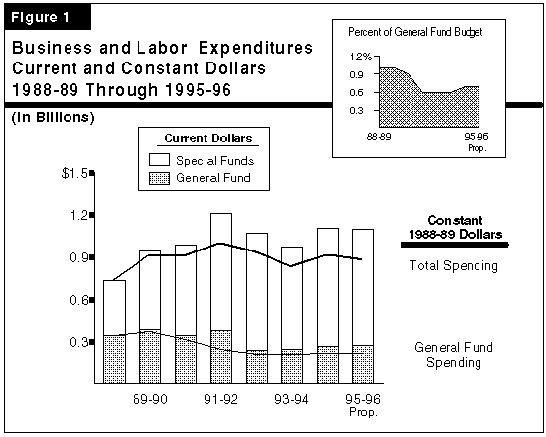
Spending by Major Programs
Figure 2 provides the spending trends for selected major business and labor programs from 1993-94 through 1995-96. As the figure shows, only one agency (Trade and Commerce) shows a significant percentage change in proposed General Fund expenditures between the current and budget years (a 21 percent increase). Two other programs show large percentage changes in special fund expenditures: Corporations (a 28 percent increase) and the Energy Commission (a 48 percent decrease).
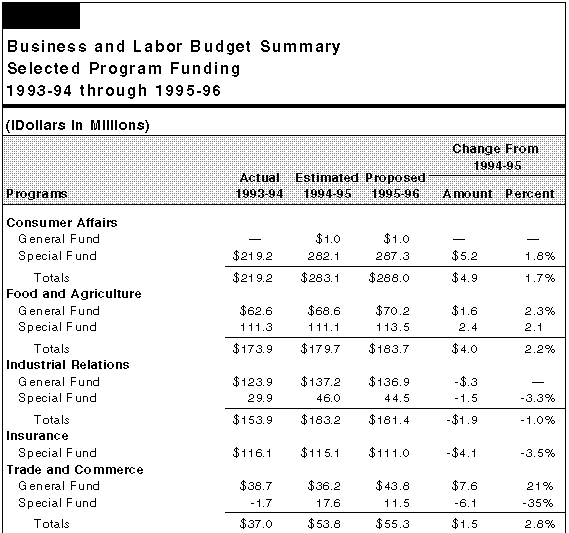
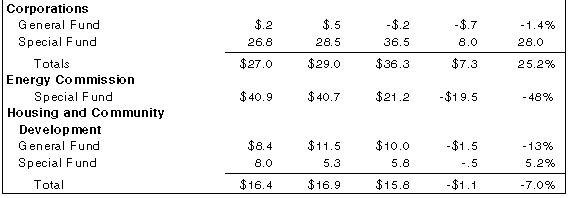
Major Budget Changes
Figure 3 summarizes major budget changes proposed for business and labor programs. As shown in the figure, there are a variety of relatively small dollar increases in General Fund program expenditures. These include $5.8 million for the Trade and Commerce Agency to increase its international trade and tourism programs and $2.3 million for the Department of Industrial Relations to pay higher facility rental costs in San Francisco.
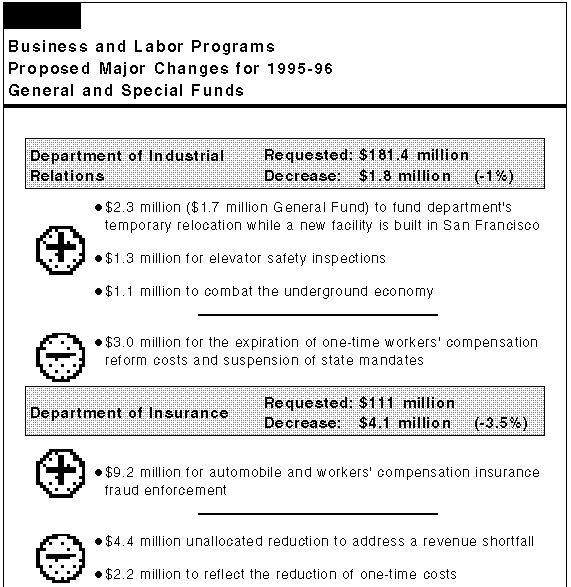
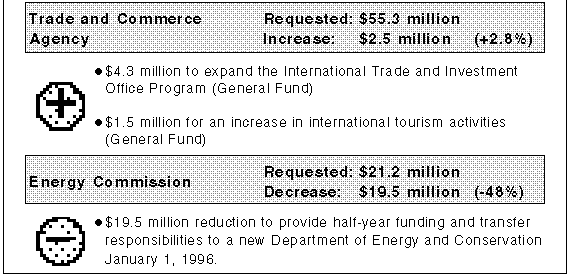
The figure also shows proposals for several departments to decrease their expenditures for certain programs. For example, the figure shows a $19.5 million overall decrease in the Energy Commission's proposed expenditures. This reduction reflects the administration's proposal to provide only half-year funding for the commission and transfer its functions to a new Department of Energy and Conservation. The figure also shows a $4.4 million unallocated reduction in the Department of Insurance to address a revenue shortfall and a $1.5 million reduction to the Department of Housing and Community Development for reduced workload in housing programs.
Return to Analysis and Perspectives and Issues Page





